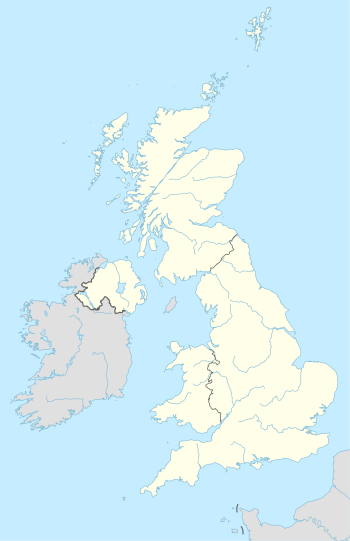Nuclear power in the United Kingdom generated 16.1% of the country's electricity in 2020.[1] As of August 2022[update], the UK has 9 operational nuclear reactors at five locations (8 advanced gas-cooled reactors (AGR) and one pressurised water reactor (PWR)), producing 5.9 GWe.[2] It also has nuclear reprocessing plants at Sellafield and the Tails Management Facility (TMF) operated by Urenco in Capenhurst.
The United Kingdom established the world's first civil nuclear programme,[3] opening a nuclear power station, Calder Hall at Windscale, England, in 1956. The British installed base of nuclear reactors used to be dominated by domestically developed Magnox and their successor AGR reactors with graphite moderator and CO2 coolant but the last of those are nearing the end of their useful life and will be replaced with "international" pressurised water reactors. At the peak in 1997, 26% of the nation's electricity was generated from nuclear power. Since then several reactors have closed and by 2012 the share had declined to 19%.[4] The older AGR reactors have been life-extended,[5][6] but they are now towards the end of their life.
In October 2010, the Cameron–Clegg coalition took forward the previous Labour government's plans[7] for private suppliers to construct up to eight new nuclear power plants.[8] The Scottish Government, with the backing of the Scottish Parliament, has stated that no new nuclear power stations will be constructed in Scotland.[9][10] E.ON UK, RWE npower and Horizon Nuclear Power have been pulling out of their initial plans for developing new nuclear power plants, placing the future of nuclear power in the UK in some doubt. Despite this, EDF Energy is still planning to build four new reactors at two sites, with construction ongoing at Hinkley Point in Somerset.[11][12] In light of the 2022 Russian invasion of Ukraine, the government of Boris Johnson announced a renewed commitment to nuclear power, using the EPR and potentially other PWR designs as well as yet-to-be-developed small modular reactors in a push towards energy independence and decarbonisation while replacing the ageing AGR reactors and phasing out gas and coal for electricity generation. While there is a de facto nuclear power phaseout underway in Scotland and there are plans to replace existing reactors with newly-built ones in England and Wales (sometimes using existing sites for the new reactors), no nuclear power plant has ever been built in Northern Ireland.
EDF Energy owns and manages the five currently operating and three de-fuelling reactor sites.[13] Four new plants are proposed to be built in the next few decades. All nuclear installations in the UK are overseen by the Office for Nuclear Regulation.
- ^ "UK ENERGY IN BRIEF 2021" (PDF). Department for Business, Energy and Industrial Strategy. p. 28. Retrieved 24 January 2022.
- ^ "Nuclear Power in the World Today: Updated March 2022". World Nuclear Association. Retrieved 19 April 2022.
- ^ "Osborne hails UK nuclear deal with China as 'new dawn'". Financial Times. 17 October 2013. Archived from the original on 11 December 2022. Retrieved 25 October 2014.
the country that built the first civil nuclear power station
- ^ "Nuclear accounts for 19% of UK electricity generation in 2012". Nuclear Engineering International. 25 July 2013. Retrieved 27 July 2013.
- ^ Seawright, Stephen (12 June 2006). "Nuclear stations may stay on line to bridge the gap". The Daily Telegraph. London. Archived from the original on 15 June 2006. Retrieved 20 May 2010.
- ^ Cite error: The named reference
nei-20120220was invoked but never defined (see the help page). - ^ "Blair presses the nuclear button". The Guardian. 17 May 2006.
- ^ Eight new nuclear power stations despite safety and clean-up concerns The Daily Telegraph. 18 October 2010 (accessed 29 March 2011)
- ^ "Answers to your questions on energy in Scotland". The Scottish Government. Retrieved 5 May 2011.
- ^ "Official Report 17 January 2008". The Scottish Parliament. Archived from the original on 20 June 2009. Retrieved 5 May 2011.
- ^ "EDF Energy New Nuclear Build". Retrieved 22 October 2012.
- ^ "National Infrastructure Planning Hinkley Point C". Archived from the original on 19 September 2010. Retrieved 22 October 2012.
- ^ Nuclear capacity in the UK (PDF) (Report). gov.uk. 2017. Retrieved 15 January 2019.
